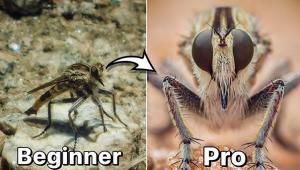Digital Help
Q And A For Digital Photography
| This department will attempt to provide solutions to problems readers may have getting into and using digital cameras, scanning, and using digital photographic images with a computer and different kinds of software. All questions sent to me will be answered with the most appropriate information I can access and provide. However, not all questions and answers will appear in this department. Readers can send questions to me addressed to Shutterbug magazine, through the Shutterbug web site, directly via e-mail to: editorial@shutterbug.net or fotografx@mindspring.com or by US Mail to: PO Box 2830, Lompoc, CA 93438. Transparencies From
Digital For Publication A.
Unless the original photograph was made on film (slide/transparency),
and your original is digital, only a very few, very antiquated publishers
would prefer a transparency. For a decade now all of my work has been
accompanied by illustrations comprised of TIFF files in high resolution
recorded on a CD-R disc. How To Learn To Scan
And Add A Logo To A Digital Photo Image A. You
have asked about two rather distinct question subjects, scanning and
adding or compositing one image onto another. I have covered both topics
(relative to some scanners) in articles published in Shutterbug, some
of which can be found and recalled on our website, www.shutterbug.net.
In addition, there is quite a bit of support on various websites relative
to specific scanners and scanning software at www.epson.com, www.microtek.com,
and particularly from Lasersoft at www.silverfast.com. Converting Home Movie
Film To Digital A.
Some years ago there were conversion services that used high-quality
equipment to convert 8mm film to videotape, and with reasonable quality.
I have not seen an ad for this service for nearly 10 years, so don't
really know where even to look other than doing some laborious Internet
searching. And, as far as I know there is not any equipment made which
would accomplish a direct conversion from 8mm film to digital video,
although making a digital conversion from analog videotape is supported
and not that difficult to accomplish. Paint Shop Pro Color
Management Yet Again An Animated Panorama A.
The effect you have seen on websites is probably either digital video
or animation. Stitching 24 stills together will not obtain the effect
of the piece revolving in one place. You could however achieve this
to some degree using stills to make a digital video using a video-editing
program, or even a simple GIF animation capability. New To Photography A.
Adobe's Photoshop Elements has the most built-in and company-sponsored
support of just about any software sold. If you have not explored all
of the Help and Tutorials installed with Elements, as well as Hints
and Recipes included in Elements, you can obtain further and copious
information on how to use Photoshop and Elements from the Adobe website
at the two following URLs: http://studio.adobe.com/expertcenter/photoshop/main.html
and www.adobe.com/support/products/photoshopel.html. Reader Tip On Scanning
And Printing Black And White A. Thanks
for your e-mail with included tips. I believe I pretty well covered
much of what you described in a Shutterbug article published in the
December 2001 issue titled, "Digital In Black And White--Ink
Jet Printing Problems And Solutions." I also covered an advanced
black and white scanning technique in a more recent article (September
2002 issue) titled, "B&W Negative Scanning--A Step By
Step, Easy Way To Quality Images." |


































